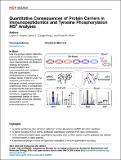Notice
This is not the latest version of this item. The latest version can be found at:https://dspace.mit.edu/handle/1721.1/135614.2
Quantitative Consequences of Protein Carriers in Immunopeptidomics and Tyrosine Phosphorylation MS2 Analyses
Author(s)
Stopfer, Lauren E; Conage-Pough, Jason E; White, Forest M
DownloadPublished version (3.260Mb)
Publisher with Creative Commons License
Publisher with Creative Commons License
Creative Commons Attribution
Terms of use
Metadata
Show full item recordAbstract
Utilizing a protein carrier in combination with isobaric labeling to "boost" the signal of other low-level samples in multiplexed analyses has emerged as an attractive strategy to enhance data quantity while minimizing protein input in mass spectrometry analyses. Recent applications of this approach include pMHC profiling and tyrosine phosphoproteomics, two applications that are often limited by large sample requirements. While including a protein carrier has been shown to increase the number of identifiable peptides in both applications, the impact of a protein carrier on quantitative accuracy remains to be thoroughly explored, particularly in relevant biological contexts where samples exhibit dynamic changes in abundance across peptides. Here, we describe two sets of analyses comparing MS2-based quantitation using a 20× protein carrier in pMHC analyses and a high (~100×) and low (~9×) protein carrier in pTyr analyses, using CDK4/6 inhibitors and EGF stimulation to drive dynamic changes in the immunopeptidome and phosphoproteome, respectively. In both applications, inclusion of a protein carrier resulted in an increased number of MHC peptide or phosphopeptide identifications, as expected. At the same time, quantitative accuracy was adversely affected by the presence of the protein carrier, altering interpretation of the underlying biological response to perturbation. Moreover, for tyrosine phosphoproteomics, the presence of high levels of protein carrier led to a large number of missing values for endogenous phosphopeptides, leading to fewer quantifiable peptides relative to the "no-boost" condition. These data highlight the unique limitations and future experimental considerations for both analysis types and provide a framework for assessing quantitative accuracy in protein carrier experiments moving forward.
Date issued
2021Journal
Molecular and Cellular Proteomics
Publisher
Elsevier BV